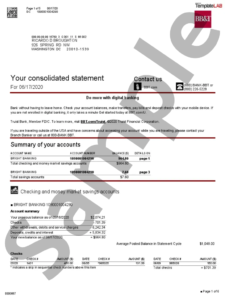Introduction
Bank statements are quintessential financial documents that present a clear picture of an individual’s or business’s monetary activities within a stipulated period. From personal use to business necessities, understanding how to make fake bank statement can be a lifesaver in various situations. Let’s dive deep into the meticulous process.
Make Bank Statement: Why It’s Important
Bank statements are more than just pieces of paper. They’re a reflection of your financial behavior and can be crucial in many situations:
- Loan Approvals: Lenders scrutinize them to assess your creditworthiness.
- Renting a Property: Landlords might want a peek to ensure you can pay the rent.
- Financial Planning: They’re a mirror to your spending habits.
However, there are times when one might need to make a bank statement for legitimate purposes. Here’s how.
The Legitimate Grounds for Making a Bank Statement
Before jumping into the steps, it’s essential to understand when it’s legally acceptable to create a bank statement:
- Mock-ups for Educational Purposes: Universities, colleges, and financial educators often require simulated bank statements for teaching.
- Theatrical and Film Use: Prop bank statements are indispensable in movies and plays to depict a financial scenario.
- Personal Record Keeping: Sometimes, for personal analysis, creating a projected bank statement can help in planning ahead.
Remember, forging a bank statement for illicit gains can land you in legal trouble. Always be transparent and honest in your intentions.
Steps to Make a Genuine-Looking Bank Statement
Understand the Layout
Almost every bank follows a set format:
- Header: Contains the bank’s name, logo, and branch details.
- Customer Details: Your name, address, account number, and other relevant details.
- Statement Period: Specifies the time duration for which the statement is generated.
- Transaction Details: A chronological list of all transactions.
Use the Right Software
Microsoft Excel or Google Sheets is perfect for this. They offer templates and grids to replicate the bank statement’s look. For a more professional finish, consider using Adobe Acrobat.
Input Accurate Details
Remember, if this is for personal use, ensuring accuracy is paramount. Predict your future transactions, or if you’re replicating past ones, ensure they match your records.
Be Mindful of the Math
A simple mistake can throw off the entire statement. Make sure debits and credits are accurately accounted for and the final balance tallies.
Review and Refine
Look for discrepancies. Perhaps there’s a transaction missing? Or maybe the date is wrong? It’s always in the details.
Print on Quality Paper
If you’re presenting this statement physically, ensure it’s printed on quality paper, similar to real bank statements.
Consider Digital Formats
Many institutions now accept bank statements in digital formats. In such cases, save your document as a PDF for universal compatibility.
Mistakes to Avoid When Making a Bank Statement
Creating a bank statement requires precision. Here are some common pitfalls:
- Overlooking Dates: Ensure all transactions align chronologically.
- Mismatched Totals: Always double-check your totals.
- Using Inconsistent Fonts: Uniformity is key. Stick to one font throughout.
Real-life Applications of a Simulated Bank Statement
Apart from the previously mentioned uses, simulated bank statements can also play a role in:
- Financial Literacy Workshops: They’re great tools to teach budgeting and financial planning.
- For Mock Financial Audits: Companies can use them to train their internal audit teams.
FAQs
- Is it legal to make a bank statement?
Yes, as long as it’s for legitimate purposes like education, theatrical use, or personal financial planning. Using it to deceive or commit fraud is illegal. - Which software is best for creating a bank statement?
Microsoft Excel, Google Sheets, and Adobe Acrobat are the go-to choices for many. They’re user-friendly and offer precision. - How do I ensure my bank statement looks authentic?
Stick to the standard layout, use consistent fonts, and ensure your math is accurate. If possible, cross-reference with a genuine bank statement. - Can I use a simulated bank statement for official purposes?
No, simulated or mock bank statements should not be used for official or legal purposes unless explicitly stated. - Is there a difference between a bank statement and a bank certificate?
Yes, a bank certificate is a document from the bank confirming you have an account, while a statement provides transaction details. - Can I make a digital bank statement?
Yes, in fact, many prefer digital formats now. Ensure you save it as a universally accepted format like PDF.
Conclusion
Creating a bank statement, whether for educational purposes, theatrical needs, or personal financial planning, requires accuracy, attention to detail, and transparency in intent. Armed with this guide, you’re well-equipped to make an authentic-looking bank statement for legitimate purposes. Always remember the legal boundaries and utilize this knowledge responsibly.



